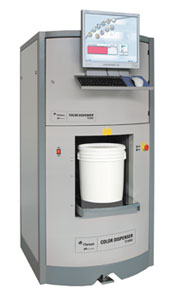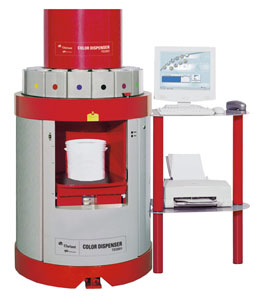Achieving the Full Potential of Low- and Zero-VOC Paints
The move from traditional coatings to formulations with low- or zero-VOC is a well-established industry trend. Most major paint manufacturers offer a line of low- or zero-VOC products to address environmental, health and aesthetic concerns associated with solvents, which range from unpleasant odor to smog formation, eye, nose and throat irritation, and suspected links to serious illness. The U.S. EPA requires paints labeled “low-VOC” to contain no more than 250 g/L (latex) or 380 g/L (oil-based). Products labeled “VOC free” can contain no more than 5 g/L.
Although these new-generation paints offer important health and ecological benefits compared to traditional products, they present unique challenges that can detract from their overall value and cause second thoughts about making the switch from solvent-based paint. These include quality and consistency problems caused by standard dispensing technology that is not optimized for low- and zero-VOC formulations, poor exterior performance and durability, and a limited color palette.
To obtain the best results with low- and zero-VOC paints, it is important to use dispensing equipment that has been specifically designed for these formulations, as well as colorants that can deliver improved aesthetics and a longer useful life, particularly in harsh climates.
 Credit: Clariant Credit: Clariant
|
| Clariant’s Italtinto Color Dispenser TD 9002. |
Solving Dispensing Issues
The reduction or elimination of solvents in low- and zero-VOC colorants can lead to problems when using dispensing equipment originally designed for conventional VOC-containing colorants. The new colorants tend to dry faster and have higher levels of solids, particularly in the case of high-strength colorants. With water as the carrier and without ethylene glycol as a lubricant and conditioner, these colorants can rapidly dry out in dispensing nozzles. They can also settle in canisters, leading to caking, clogging and loss of homogeneity. Technologies that do not incorporate recirculation capabilities are more susceptible to settling or separation of the colorant, producing inconsistent color quality and inaccurate tints. Settling of colorant can clog dispensing lines, restrict colorant flow and lead to problems such as a hose rupturing and leaking. All of these scenarios are expensive to repair and result in customer dissatisfaction.
Another challenge of low- and zero-VOC colorants is their reduced ability to tolerate shear. Shear forces, which are imparted into liquid when it is pumped, are undesirable when applied to the handling of colorants used to tint paint. High levels of shear can disturb or change the fluid, affect the pigment grind and may result in undesirable changes in the rheology of materials. Such changes can affect the accuracy and repeatability of a machine, typically leading to more-frequent calibration and maintenance, and increased cost of ownership.
Additionally, some of the latest generations of low- and zero-VOC colorants are formulated using acrylic resins, which are less tolerant of shear than the liquids utilized in conventional colorants containing VOCs. High levels of shear can potentially disturb the delicate balance present in an emulsion, causing “skinning,” or conversion to a solid, which can lead to grittiness when the solid pieces of skin are mixed back into the emulsion. Another negative effect is a destabilized condition arising from exposure to extreme conditions. The shock of shear forces can cause suspended plastic particles to “kick out” of the emulsion.
Many existing colorant dispensing systems, especially manual systems, are up to 25 years old, and this older technology is not well suited for low- and zero-VOC colorants. Older dispensing machines in the North American market are not equipped with mechanisms such as sealed capping devices to prevent colorants from drying out. Further, many machines do not offer recirculation functionality because it is an expensive feature to incorporate into certain machine designs, and manufacturers have frequently avoided including it in their equipment for cost reasons.
Another problematic feature of traditional colorant dispensing systems – particularly those without recirculation – is long lengths of tubing that run from a pump to the dispensing point. A machine utilizing a long tube loaded with colorant and lacking recirculation can experience stagnation, resulting in a colorant that is not well homogenized. The dispensing of a non-uniform colorant into a paint system will produce inconsistent tints. Settled colorant can also build up in these tubes, causing them to burst when the liquid being pumped through the tube encounters a clog.
Another equipment issue accelerated by non-VOC-containing colorants is corrosion of internal metal parts. This can be caused by exposure to higher free water content, the presence of dissimilar metals or the elimination of ethylene glycol. For all these reasons, redesigned, point of sale (PoS) dispensing systems are needed for optimal equipment performance and color quality.
 Credit: Clariant Credit: Clariant |
| Clariant’s Italtinto Color Dispenser TD 2001. |
Features of PoS Dispensing Systems
Following are key features and capabilities of dispensing systems that address the specialized requirements of low- and zero-VOC paints.
- Piston pump: A piston is a very scalable technology; you can vary both the diameter of a piston and the length of its stroke. Importantly, a piston operates at a low speed compared to other types of technologies. In contrast, high-speed devices are more prone to wear and cavitation, especially when air bubbles are present in a colorant. A piston does not rely on any type of meshing assemblies to provide its pumping action. Meshing assemblies require precise tolerances; all colorants tend to demonstrate abrasive characteristics that will lead to degradation of efficiency and inaccuracy. Also, piston pumps are virtually calibration-free. They are extremely precise (able to dispense in miniscule increments) and maintain their accuracy exceptionally well for long periods of time.
- Direct or near-direct dispensing: Dispensing directly from the canister into the container avoids hoses or tubing that can experience clogging and settling. Additionally, a device designed to seal the dispenser nozzle should be provided to avoid drying out between operations.
- Recirculation: A recirculating system for colorants should be programmable for duration and period, allowing adjustments or tuning of these variables depending upon the characteristics of the colorants. A typical setting might recirculate colorants for 15 to 30 seconds every hour.
- Non-metal parts: To avoid the risk of galvanic corrosion from low- and zero-VOC formulations, the dispenser should have plastic or non-corrosive metal in parts that come into contact with the colorants, and avoid using combinations of numerous types of metals.
Clariant Italtinto PoS colorant dispensers have been specifically built to handle all types of low- and zero-VOC water-based and universal colorants, and address the sustainability requirements of the coatings industry. These systems work with a single motor and feature high-precision, stainless steel piston pumps that do not use tubing or hoses. Parts that contact colorants are made from thermoplastics or non-corrosive metal.
More than 10,000 of these dispensers have been sold worldwide. Typically, customers comment that the machines are extremely reliable due to their simplicity of construction. In the unlikely event that a machine malfunctions, the customer is frequently able to repair the unit without the need for outside intervention. Other machines do not lend themselves well to self-maintenance, since such machines often feature complicated designs and require specialized tools, and their component costs can be high.
Improving Performance
Once a low- or zero-VOC paint has been tinted successfully, the focus turns to its performance and durability, particularly for exterior applications. Although the building and construction market as a whole suffered a major downturn during the recession, and facility maintenance was often postponed due to lack of funds, building owners are now beginning to tackle these projects.
However, money remains tight and there is a strong trend toward seeking greater value, including longer usage cycles for materials. Therefore, when considering low- and zero-VOC paints for building exteriors, customers are demanding high quality, longer life and retention of good aesthetics because they are unwilling to pay for frequent repainting. Unfortunately, some of these paints do not perform as well as solvent-based paints.
Current criticisms of exterior paint made with low or no solvents include:
- Substandard coverage: Non-opaque pigments with relatively lower loadings in colorants often lead to poor coverage. Opaque pigments have relatively higher durability and lower oil absorption, and can be used at much higher loadings without any negative effects on colorant viscosity. Thus, they offer much improved coverage and performance.
- Poor consistency: Some of the low- or zero-VOC colorants in the market today dry out too quickly, thicken up and therefore cannot be dispensed accurately, leading to inconsistent color development. This is primarily due to poor formulation and can only be improved by major changes in composition of the colorant.
- Shorter repainting cycles: Frequently, painting needs to be redone often due to initial sub-optimal coverage, coupled with poor weatherability, color fading from reaction with uncured masonry and other ageing factors.
- Negative impact of alkaline substrates: When used in coloration of flat paints for alkaline substrates (cement, etc.), most organic pigments show efflorescence, which means that pigments in paint react with alkalinity under humid conditions, leading to major color change. Only inorganic and a few selected organic pigments do not exhibit this behavior and are suitable for paints applied to alkaline substrates.
- Poor weatherability: Pigments are primarily responsible for the color consistency of a paint system. For cost reasons, many low- or zero-VOC colorant systems are based on old pigment technology, which is not very durable, especially in the yellow, orange and red categories. Superior pigment chemistry is necessary to achieve improved weather fastness. Benzimidazolone and diketopyrrolopyrrole (DPP) chemistries offer much better weather fastness over the commonly used Hansa and naphthol chemistry-based pigments.
In addition, low- and no-VOC exterior paint systems are known for a limited color choice, focusing on muted shades. Only a limited number of organic pigments commonly used in durable exterior paints have resistance to efflorescence, high opacity and durability. Therefore, only inorganic and a few organic pigments are suitable to achieve these properties. Some of these pigments are relatively expensive and are not used in most current systems.
This limited color palette does not address customers’ desire for greater choice and brighter colors for architectural applications. In particular, architects and contractors are always looking for bright shades in durable paints for commercial buildings to minimize repainting (since the initial cost of paint is always much lower than that of repainting). Many corporations choose bright colors to stand out for branding purposes, and are willing to pay for durable paint systems.
To address these issues, Clariant’s Hostatint® TS Exterior system colorants are based on select inorganic and proven durable organic pigments. The inorganic pigments have high opacity, bright hues and excellent resistance to efflorescence. When blended with a high-durability lone organic pigment, they exhibit bright red, orange and yellow shades that cannot be achieved with blends of common organic pigments. For example, the Hostatint TS Exterior system uses Pigment Yellow 184 in place of Pigment Yellow 74, Pigment Blue 28 instead of Pigment Blue 15:2 (phthalocyanine blue) and Pigment Red 168 as the bright scarlet for shading purposes.
Hostatint TS Exterior system colorants are based on historically high-durability and high-opacity pigments, with relatively high loading. These colorants have been used for exterior applications on concrete and other substrates along the Mediterranean coast for many years with excellent color retention. Assuming the binder holds out, paints using these colorants maintain color for many years under harsh weather conditions.
Conclusion
The adoption of low- and zero-VOC paints is expected to accelerate due to increasingly stringent environmental regulations and consumer interest in sustainability. However, users expect high quality, consistency, durability and broad color choice from these new paints. Combining improved dispensing systems and colorant formulations that have been optimized for the specific properties of low- and zero-VOC paints can help drive greater use of these products while delivering higher operator and user satisfaction.
Looking for a reprint of this article?
From high-res PDFs to custom plaques, order your copy today!




.webp?height=200&t=1670827328&width=200)
